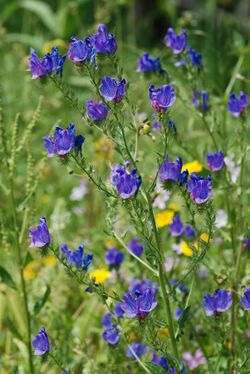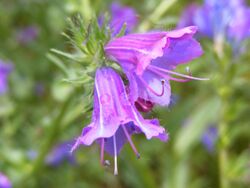Biology:Echium plantagineum
| Echium plantagineum | |
|---|---|

| |
| In Portugal | |
| Scientific classification | |
| Kingdom: | Plantae |
| Clade: | Tracheophytes |
| Clade: | Angiosperms |
| Clade: | Eudicots |
| Clade: | Asterids |
| Order: | Boraginales |
| Family: | Boraginaceae |
| Genus: | Echium |
| Species: | E. plantagineum
|
| Binomial name | |
| Echium plantagineum | |
Echium plantagineum, commonly known as purple viper's-bugloss[1] or Patterson's curse, is a species of the genus Echium native to western and southern Europe (from southern England south to Iberia and east to the Crimea), northern Africa, and southwestern Asia (east to Georgia).[2][3] It has also been introduced to Australia , South Africa , and United States , where it is an invasive weed. Due to a high concentration of pyrrolizidine alkaloids, it is poisonous to grazing livestock, especially those with simple digestive systems, such as horses.
Description
Echium plantagineum is a winter annual plant growing to 20–60 cm tall, with rough, hairy, lanceolate leaves up to 14 cm long. The flowers are purple, 15–20 mm long, with all the stamens protruding, and borne on a branched spike.[4][5]
Taxonomy
The Latin genus name comes from the Greek word ekhis, which means viper (a type of snake), possibly due to the seeds resembling a viper's head or the forking at the end of the thin flower style resembles a viper's tongue. The plant roots when eaten with wine, are claimed to provide a folk cure for a snakebite.[6] The Latin specific epithet plantagineum refers to the leaves of the plant, which are similar to those of a plantain.[6]
Invasive species
E. plantagineum has become an invasive species in Australia, where it is also known as Salvation Jane (particularly in South Australia),[6] blueweed, Lady Campbell weed, Paterson's curse and Riverina bluebell.[7]
In the United States , the species has become naturalised in parts of California , Oregon, and some eastern states and areas such as northern Michigan.[8] In Oregon, it has been declared a noxious weed.[9]
Toxicity
E. plantagineum contains pyrrolizidine alkaloids, so is poisonous to nonruminants.[10][11] When eaten in large quantities, it causes reduced livestock weight, and death in severe cases, due to liver damage.[7] Paterson's curse can also kill horses,[12] and irritate the udders of dairy cows and the skin of humans. After the 2003 Canberra bushfires, a large bloom of the plant occurred on the burned land, and many horses became ill and died from grazing on it.[13] Because the alkaloids can also be found in the nectar of Paterson's curse, the honey made from it should be blended with other honeys to dilute the toxins.
References
- ↑ (xls) BSBI List 2007, Botanical Society of Britain and Ireland, https://bsbi.org/download/3542/, retrieved 2014-10-17
- ↑ Echium plantagineum. Flora Europaea.
- ↑ {{citation | mode = cs1 | title = Echium plantagineum | work = Germplasm Resources Information Network (GRIN) | url = | publisher = [[Organization:Agricultural Research ServAgricultural Research Service (ARS), United States Department of Agriculture (USDA) | access-date = 2017-12-18 }}
- ↑ Blamey, M. & C. Grey-Wilson. Flora of Britain and Northern Europe. 1989. ISBN:0-340-40170-2
- ↑ Piggin, C. M. & A. W. Sheppard. (1995). Echium plantagineum L. In: Groves, R. H., R. C. H. Shepherd, and R. G. Richardson, (eds.) The Biology of Australian Weeds Vol 1. R. G. and F. J. Richardson, Melbourne. pp 87-110.
- ↑ 6.0 6.1 6.2 W. T. Parsons, William Thomas Parsons and E. G. Cuthbertson Noxious Weeds of Australia, p. 325, at Google Books
- ↑ 7.0 7.1 Lewis Kahn and David Cottle (editors) Beef Cattle Production and Trade, p. 272, at Google Books
- ↑ "Paterson's Curse Echium plantagineum in the Pacific Northwest". Oregon State University. October 2007. http://extension.oregonstate.edu/catalog/pdf/pnw/pnw602-e.pdf.
- ↑ "Paterson's Curse". Oregon Department of Agriculture. February 12, 2008. http://www.oregon.gov/ODA/PLANT/WEEDS/Pages/profile_pcurse.aspx.
- ↑ The MERCK Veterinary Manual, Table 5
- ↑ D. Jesse Wagstaff International Poisonous Plants Checklist: An Evidence-Based Reference, p. 141, at Google Books
- ↑ Patersons Curse and Horse Health
- ↑ Paterson's curse poisoning in horses. Animal Health Surveillance Quarterly Report 8(4) Oct-Dec 2003.
External links
Wikidata ☰ Q159280 entry
 |


